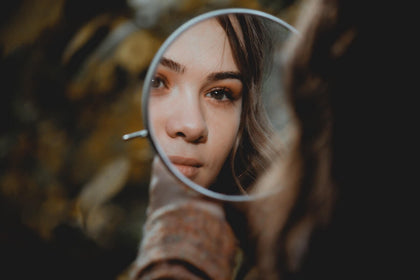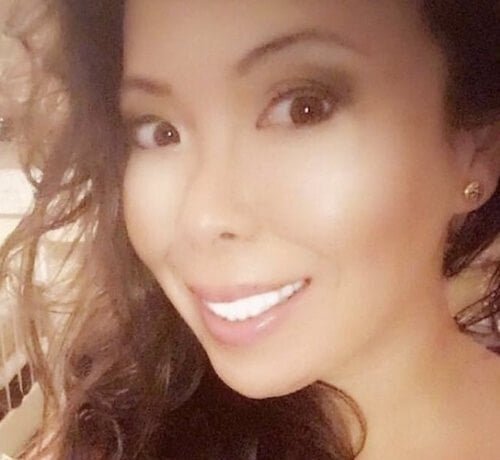When you think of dandruff, what likely comes to mind are visions of white flakes dusting your shoulders and clothes. Dandruff and dryness in the scalp, skin and hair often go hand in hand.
However, when things start to get even more noticeable — and more uncomfortable — or you start noticing discolored flakes or discomfort in areas other than simply your scalp and shoulders, it may signify a deeper issue. If OTC shampoos and other remedies aren’t quite cutting it, there’s a possibility you’re suffering from dandruff’s more serious counterpart: seborrheic dermatitis. Find out what you can do to soothe your irritated scalp and get relief.
#include-related-slider#
What Is Seborrheic Dermatitis?
Simply put, seborrheic dermatitis is the more severe version of those pesky white flakes. Think: Dandruff multiplied to another level of discomfort and visibility.
Like dandruff, seborrheic dermatitis is a common scalp skin condition that is chronic. But, there’s no reason to be alarmed. Neither is contagious, and there are both over-the-counter and prescription treatment options available to manage seborrheic dermatitis. Finally, and perhaps most important, is to keep things in perspective: There is little to no scientific evidence to link permanent hair loss or hair growth issues with seborrheic dermatitis.
Related: Does Dandruff Cause Hair Loss? A Dermatologist Explains
Seborrheic Dermatitis Warning Signs
“If you notice patches of redness, flaking and oily or dry scales, especially beyond the scalp, this could be seborrheic dermatitis,” said Brooke Grant Jeffy, M.D., a board-certified dermatologist. “This form of dermatitis leads to redness, flaking and crusting on parts of the body rich in oil-producing glands, such as the scalp, face and chest. It most often appears as flaking diffusely through the scalp and/or eyebrows. It often causes redness and scaling around the nose. It may sometimes appear in the beard area. When it occurs on the chest, it is usually right in the middle and more of a greasy, red rash and less flaky. There is not a cure, but it may act up more at various times and eventually will often spontaneously resolve.”
Dandruff presents itself primarily in the scalp, typically resulting in white flakes. However, if you see flakes that are yellow and/or greasy, seborrheic dermatitis is most likely the reason. A patient with the symptoms of seborrheic dermatitis may also experience the condition on the face.
Try It: GRO Scalp Detoxifying Serum
Face Facts
“The facial areas that are most commonly involved are the eyebrows, glabella (frown) area, and nasolabial folds (smile lines), central cheeks and ears," said Kenneth Mark, M.D., cosmetic dermatology expert. "It is important to note that this rash can also be quite itchy."
The visible inflammation may extend to these facial areas:
- Around the mustache and beard
- Eyebrows
- Ears
- Chest
Some of the other symptoms of seborrheic dermatitis may include:
- Itching
- Burning
- Scaly patches
- Oily skin
- Blepharitis
- Rashes
- Folliculitis
Read: Why Does My Hair and Scalp Hurt? Doctors Explain
Does Seborrheic Dermatitis Cause Hair Loss?
Generally, the skin condition itself doesn’t cause hair loss in most people. The exception is when things such as oxidative stress and/or an increase in oil production lead to extra sebum. In turn, this can trigger an overgrowth of Malassezia, a type of yeast that normally lives on the skin.
An overgrowth of Malassezia yeast is thought to be related to seborrheic dermatitis. These flare-ups are a result of the body's inflammatory response to an overwhelming increase of Malassezia yeast. When it grows out of control, it can cause inflammation that makes hair growth more difficult.
Itching and scratching as a result of this yeast overgrowth may injure the hair follicles in some people. The good news is that any hair loss resulting from this is typically only temporary. Hair growth should begin to reoccur once the problem is resolved.
Related: What Causes Hair Loss? Every Trigger Explained
Understanding the Triggers: Stress SOS
“Most often, the yeast, Malassezia, which is usually present on our skin without causing rashes, can be a trigger,” said Dr. Mark. “It is interesting to note that on the one hand, it is considered an example of eczematous dermatitis, but it can also be more of an overlap of psoriasis, so much so that some call it “sebo-psoriasis. One of the most fascinating aspects of dermatology is when the skin can give clues to underlying illnesses. Seborrheic dermatitis is often seen in patients with neurologic diseases such as Parkinson’s disease and strokes, but also in those with weakened immune systems such as HIV.”
While it's hard to pinpoint the exact cause of these dermatitis flare-ups, as is typical with physical conditions that manifest within the body, stress is a likely culprit. Beyond those with any underlying immunosuppression and neurological conditions, otherwise healthy adults with oily skin may be more likely to develop seborrheic dermatitis due to increased oil production.
“The exact causes are still not completely understood,” said Gary Linkov, M.D., board-certified plastic and hair surgeon of City Facial Plastics. “These include genetics, medical conditions, certain medications, dry weather, altered immune response and stress. Seborrheic dermatitis often cannot be prevented. It can only be treated.”
To better manage and keep seborrheic dermatitis under control, implement lifestyle techniques that help you to minimize stress, such as:
- Regular exercise
- Stress-reducing yoga poses
- Adequate sleep
- Meditation
- Practicing Mindfulness
- Other self-care practices
Shop: GRO Balance & Restore Kit
Age and Its Effects
“Seborrheic dermatitis can be itchy and can show up differently on the body depending on the age of the individual,” said Sheilagh Maguiness, M.D., pediatric dermatologist and co-founder of Stryke Club. “Overall, the etiology is largely unknown. It may be due to a complex relationship between a microbe on the skin, such as Malassezia and the individual’s immune response. Predisposition to atopic dermatitis is also a factor, especially in infants with seborrheic dermatitis."
Cradle cap and seborrheic dermatitis are used interchangeably when describing the scalp condition in infants. Cradle cap is a form of seborrheic dermatitis that usually causes greasy, yellow scaling in the scalp. As with seborrheic dermatitis, cradle cap is thought to be due to microbe overgrowth, leading to inflammation and accumulation of scale. Unlike adult seborrheic dermatitis, cradle cap will typically resolve in weeks to months.
According to Dr. Maguiness, cradle cap can be treated in all the same ways as you would treat seborrheic dermatitis in an adult. However, oftentimes, just gently scrubbing the scales off is all that is needed. The doctor's advice for infants: A soaking tub bath daily, making sure to get the face and scalp completely wet. This helps soften and remove the scales. Adding a moisturizing oil, such as sunflower oil, to the scalp following the soaking bath can help to retain moisture and prevent dryness.
Also: How to Get Rid of Dandruff Once and For All
Lather Up
As for adults, there are plentiful treatment options — from home remedies to over-the-counter shampoos and prescription medications to topical solutions.
“So far, there is no known perfect cure, but symptoms can be managed with local therapies,” said Dr. Maguiness. "Regular cleansing of the scalp and affected areas is important. Certain shampoos that reduce bacteria and fungus on the scalp are also helpful. Keep products hypoallergenic if possible. Since seborrheic dermatitis is mostly innocent, it is fine to start with gentle skin care and a medicated over-the-counter shampoo. Be sure to leave the shampoo in contact with the scalp for a full 10 minutes before rinsing."
These types of shampoos include:
- Selenium sulfide
- Coal tar shampoo
- Zinc pyrithione
- Sodium hypochlorite
Encourage Thicker Looking Hair
If you're struggling with thin, unhealthy looking hair, you should look for products that encourage thicker, fuller looking hair. In between hair wash days, use GRO Dry Shampoo to refresh your hair. It's scalp-balancing, volumizing and infuses the texturizing perks of a traditional dry shampoo with powerful, plant-based ingredients that work together to support overall hair wellness. In fact, it has the same phyto-actives as our best-selling hair serums. Pair it with regular use of GRO Hair Serum for visible results in as soon as 90 days of consistent use.
You can also get a boost of phyto-actives and vegan keratin in the shower with GRO Revitalizing Shampoo and Conditioner. Fortified with Karmatin™, a microencapsulated vegan b-silk™ protein, this shampoo and conditioner duo bonds to hair filling in the crevices of damaged hair follicles and it doesn't rinse out. The result? More shine, more moisture, color protection and hair that feels as smooth as glass.
Treat Your Scalp to Some TLC
Set your tresses up for further success by incorporating regular scalp care into your self-care routine. First, identify what a healthy scalp looks like and then consider the benefits of a scalp massage. Use a scalp massager to boost circulation in and around the scalp and hair follicles.
Also, consider applying a product that encourages a healthier looking scalp, such as GRO Scalp Detoxifying Serum. This serum soothes irritation by gently removing buildup to restore balance to the scalp.
Up Next: Dandruff vs. Dry Scalp — What's the Difference?
Remedy RX: Treatment Choices
Sometimes, over-the-counter treatments aren’t enough, and prescription medications, such as topical steroids, are required. If the inflammation worsens, itching increases or you think you may have developed a skin infection, it is time to consult with your doctor.
There are prescription medications such as oils, shampoos and creams containing topical steroids that can help with some of those more severe symptoms. Topical antifungals are another treatment option that can help to reduce the amount of Malassezia on the skin.
“Prescription anti-yeast creams such as ketoconazole 2%, either alone or in combination with steroids, can be quite effective," said Dr. Mark. "For the face, these can be prescribed as creams. For the scalp, shampoos or liquid solutions are more user-friendly.”
Other prescription treatments include:
- Keratolytics, such as salicylic acid, lactic acid, urea and propylene glycol to lift away and remove scale.
- Topical antifungal agents including zinc, selenium, ketoconazole and ciclopirox shampoo or cream to reduce Malassezia.
- Topical corticosteroids or calcineurin inhibitors to reduce inflammation.
- In resistant cases, oral antifungals, antibiotics, phototherapy or oral isotretinoin may be used.
Don't let seborrheic dermatitis stop you from living your best-tressed life! Like you, treatment options are unique and will vary from person to person. However, incorporating healthy habits in both your lifestyle and caring for your hair will boost your overall wellness.
More from VEGAMOUR
- Could Fo-Ti Be the Ingredient Your Hair Needs?
- Side Effects of Minoxidil You Can't Ignore
- What to Know About PRP for Hair Loss
- What to Expect From a Hair Pull Test at the Dermatologist's Office
Photo credit: Elisa Ph./Unsplash
Back



















